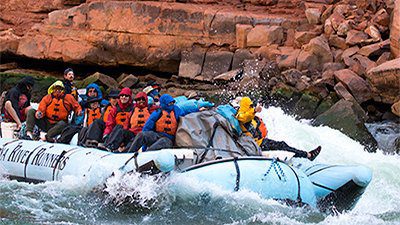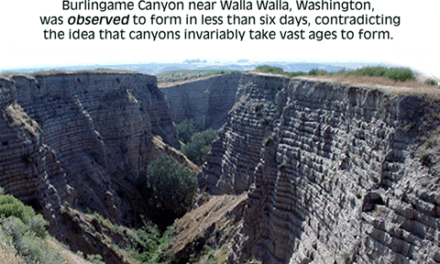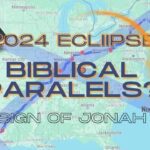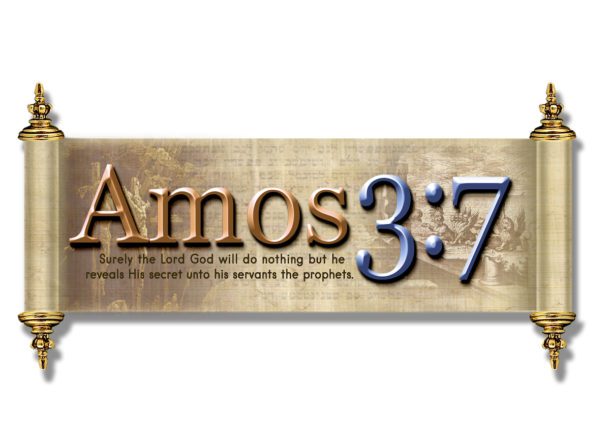“You have to be there.”
Who hasn’t heard this? You can see the photos, hear the stories, and read all about the Eiffel Tower, the Lincoln Memorial, the Taj Mahal, and Niagara Falls. But nothing compares to being there.
The team at Answers magazine planned for years to send a writer and a photographer on a raft trip down the Grand Canyon to capture a story for everyone who would love to go but probably never could. We wanted to experience the canyon’s beauty and see evidences of the flood that few ever get to see. Nine days and eight nights with a creation geologist speaker—a one-of-a-kind annual trip offered by Canyon Ministries.
My plane had just landed in Las Vegas. The hectic preparations were behind me: buying raincoats, waterproof shoes, and the like. What lay ahead? Was it worth all the effort? A flood of questions rushed through my mind, and 23 fellow travelers had similar thoughts.
Our vision of the world was about to change.
Lees Ferry
We rose early the next morning. I worried about what I was supposed to wear since we’d hit the water soon. Did I need all this rain gear yet?
We boarded a charter plane that flew us right over Hoover Dam. In the distance, we saw the southernmost cliffs of the Grand Canyon, where the waters of the Colorado River spill into open plains of the Mojave Desert.
We wouldn’t be floating that far down the river. Our trip would start far north above the Grand Canyon on the arid Colorado Plateau and end after twisting 187 miles through the heart of this deep gouge in the earth.
Our tiny, 20-seater prop plane landed at a small airstrip at Marble Canyon, a few miles from our ultimate destination. For 150 years, pioneers crisscrossed this part of the earth, where the cliffs dip down to river level and allow travelers to easily reach both sides of the Colorado River.
At the quaint Western town also named Marble Canyon, population 291, we met the others from our party at a trading post. Twenty-five rafters, two trip leaders, and four boatmen crowded into a small back room with folding chairs.
I already knew one person well, Dr. Andrew Snelling, the hardy, gray-haired geologist responsible for the instructional portion of the trip. The previous year I had also met the freckled redhead, Jon Albert, director of Canyon Ministries, who would be our guide. But who were all these others?
Jon introduced the lead boatman, Jake, a short, stocky man with short, spiky hair, small eyes and a deep tan, casually dressed in a muscle shirt. We would entrust our lives to him for the next nine days.
He mentioned that this was their first trip of the year and then got down to business. “This isn’t a tour, it’s a wilderness expedition.” In frank terms, he let us know that we would soon face an inhospitable environment, and we must never minimize the dangers.
I had never thought about that. It was jarring, to be honest. Dangerous?
We hopped onto a bus for a five-minute ride to Lees Ferry, where we were drilled on the rules of raft safety. Both hands on a rope. All personal gear tied down. We also learned about the blue bags, one big, one small. The big one held our sleeping bags and a puffy little thing they called a pillow. It also had room for any of our baggage, stuffed with clothes and things we wouldn’t need until camp. The other, called our day bag, stored our cameras, sunblock, extra layers of clothes, or anything else we’d need during the day. Each container had a number and would be ours for the whole trip. Mine was B-1. Easy to remember.
We each carried a water bottle at all times (the one “required” item at the top of our packing list). “Stay hydrated,” Jake repeated throughout the trip. “We’re in a desert.”
We formed a line—the first of many—to pass the bulging big bags from the riverbank to the boatmen, who piled them into the middle of two massive 35-foot-long, 15-foot-wide rafts. Each looked like a pontoon boat with long, light-blue rubber floaties on each side. The boats had three independent sections, front, middle, and aft (for the motor), to absorb the blows of the rapids.
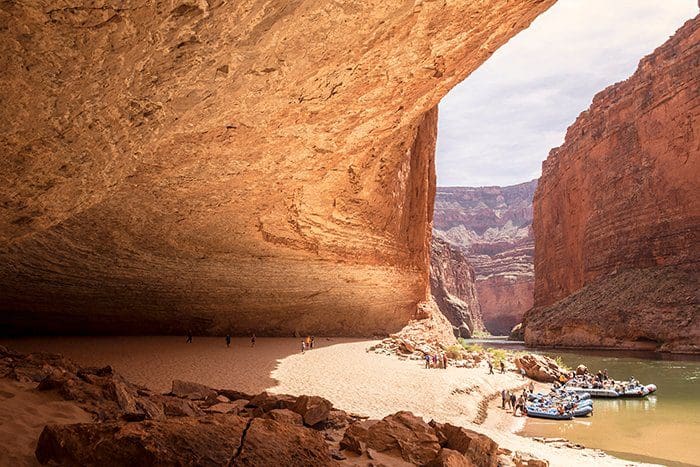
Redwall Cavern, big enough to hold 50,000 people, is just one stop on an annual nine-day creationist tour through Grand Canyon.
Our bags were covered with a huge tarp and strapped down, where they’d stay until we made camp. During the day, they served as our lumpy back rests.
The gear included folding chairs and a pile of cots. The outfitters provided tents, but they were too much trouble to set up and take down every day. (I saw only one person set up a tent the whole time.)
First Hike
Within twenty minutes of working together to load the boats, we had already become a team. You have to, in the wilderness. After the motorized rafts were loaded, we scrambled aboard, grabbed the ropes, and then traveled . . . eighty feet directly across the river. We were about to experience the first hike.

The main reason I’d come all this way was not for the whitewater rafting, but to see the geology firsthand and learn the biblical interpretation. As I got to know other passengers over the next two days, I learned that’s what everyone else had come for, too.
We clambered up the side of the hill, and Andrew pointed to the yellow and red cliffs upstream. Off in the distance to the north were even higher cliffs, the off-white-colored Navajo Sandstone. Not far below our feet at the river’s edge was the Kaibab Limestone, which downstream forms the highest layer at the rim of the Grand Canyon.
We heard a lot about the cliffs and layers over the next nine days. They became the backdrop of our life. And the constant repetition burned them into our memories as we learned their stories and what they reveal about the Lord’s handiwork as he judged the whole world in the flood’s watery cataclysm.
A River Runs Through It
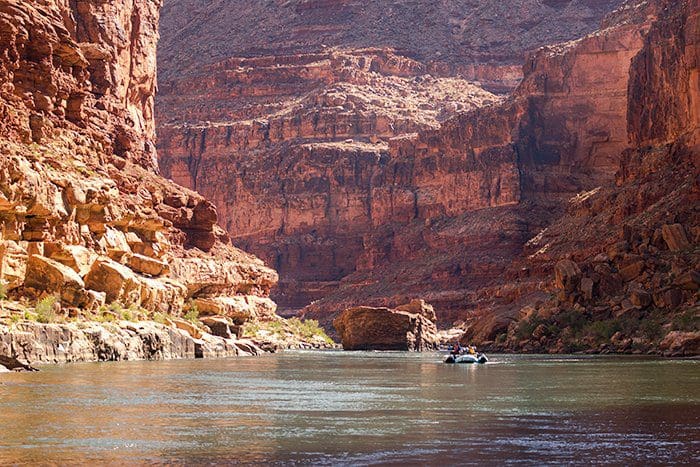
The Colorado River winds 277 miles through some of the most magnificent scenery on earth. Everywhere we looked we saw dramatic testimonies of a recent, worldwide flood, such as the lack of debris at the river’s edge.
This river and these cliffs had many stories to tell. And we now joined that story. It was our turn to experience firsthand how “the rocks cry out,” as Andrew eloquently reminded us in his first devotional (see Job 12:8; Luke 19:40).
Each stop offered unique testimonies to rapid global destruction. On the first hill we saw a petrified fern tree, 70 feet long, encased in a thick layer of rock. The only reasonable way to explain its preservation was that it was deposited quickly before it could rot. Right before our eyes was a tree plucked from the massive forests of Noah’s day!
Andrew also pointed out the lack of debris at the bottom of the cliffs. If they had been eroding for millions of years, the canyon should be filled with debris. Instead, the cliffs rose tall and stately, with barely a whisker’s worth of rocks at the bottom of their towering faces. The lack of debris is a conundrum for secular geologists, but not for creationists who believe the evidence confirms that canyon is only a few thousand years old.
Surrounded by Rocks
We climbed back down the hill, Andrew talking all the time, answering our constant questions and explaining how these deposits spread across multiple continents. How could tiny, local catastrophes occurring over millions of years—the standard explanation of evolutionary scientists—explain water flowing across entire continents to lay such deposits? Only a global catastrophe, which moved sediment around the globe, could explain these transcontinental layers.
We stumbled back to the boats and found our places. Now we began a routine that would be repeated for 187 miles. We slowly floated down the river, watching mile after mile of rocks pass by. Andrew would yell out new layers as they first appeared. Names like Redwall, Muav, and Bright Angel Shale.
At first, it was hard to keep them straight or even distinguish one from the others. But the more you see something, hour after hour, the more the sameness begins to vanish and the subtle differences surface.
We were going down the geologic column, slowly but surely. As the hours and days rolled by, the reddish, square rocks that had been below us were now hundreds of feet above us, and thin yellow lines of rock, looking like sand dunes, stared at us at eye level.
They look just like the sequence of rocks and sand that a water slough deposits today, as rushing water slows down and drops its contents. Andrew explained that the canyon was made of layers from three larger sections called megasequences. The bottom of each megasequence contains the heaviest material—a mix of boulders, pebbles, and sand. It is the first to fall out of moving water as it slows. Next, finer and finer particles fall out—silt, mud, and lime.
He believes the flood waters dropped all the sediments in a megasequence at the same time. I’ve heard about these sequences for years and seen layers of sandstone and limestone here and there, but I’ve never seen them all together in one trip.
And the scale of catastrophe! What does 1,000,000 square miles (2.4 million km2) of sand layers really look like? You don’t know until you’ve traveled down through a slice of that pie (albeit less than 200 miles). We were seeing just the edge of layers that extended deep into the earth in all directions.
Our routine included another important factor. You spend hours next to the same two people and chat with all the others around you—six or seven on a side, two boatmen per raft, and two rafts. With all that quiet time on the river, you get to know everyone well.
My first companion turned out to be the oldest adventurer on the trip, Gordon, 78, and his younger wife, Kathy. Gordon was a bit stooped, but his voice strong and his gait confident. At first I thought, “Oh, good. I won’t be the last straggler on our hikes.” Then I learned he’d hiked over 50 miles each week to prepare for this trip.
What did Gordon know that I didn’t? I hadn’t even hiked a city block to get ready.
That night Andrew gave us a simple overview of the canyon’s geology. “Conventional geologists say there is no evidence for the flood because they’re looking in the wrong place. They assume they should be looking in surface rocks if the flood was recent.
“But the best way to start is to pose the question, ‘If what the Bible says is true, what evidence should we look for?’ The flood devastated the whole world. So we should be looking for evidence of fossils laid down by water throughout the rock layers. And that’s what we find!”
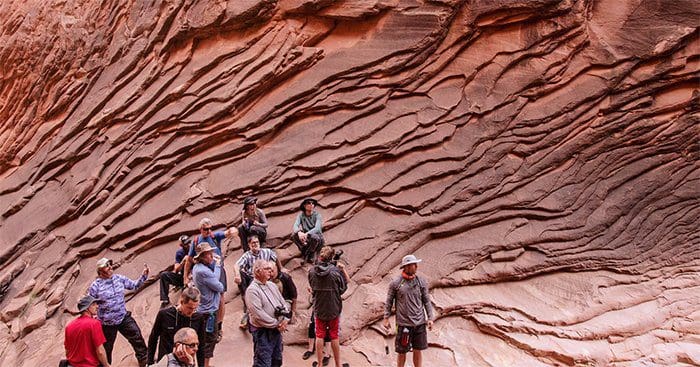
In North Canyon, we listened intently as our geologist guide explained how these unusual layers formed after rushing water gouged out the side canyon in a matter of days.
Devotions Under the Rim
Two devotions early in the trip set the stage. One was by Andrew, emphasizing that Jesus is the Creator, who made all things instantly. Just as he turned water into wine and multiplied loaves of bread without waiting a long time for fermentation and baking, he formed rocks in unique acts that would require a long time by today’s processes. To avoid confusion, God told us in his Word what really happened.
The other devotion came from Jon, the Canyon Ministries guide. He didn’t talk about the rocks, or the geology, or the adventure. He talked about God. He is a former pastor, an adventure guide from the woods of Minnesota before God called him here. His passion is to get people to make the most of this retreat from “the rim world.” We heard that term many times throughout the trip.
“Does anybody know the average amount of time people spend looking at Grand Canyon?” he asked. “Fifteen minutes.”
“They’ve put great effort and time to get to its rim. They honestly want to experience the Grand Canyon. And when they get to the edge and see the cliffs, they have an incredible wow moment. Then they ask, ‘Now what? Well, I’ll go grab a T-shirt from the gift shop,’ and away they go.
“To their credit, they have seen Grand Canyon. And you can get this idea, ‘Been there, done that. I’ve seen the vision.’ Then you wander toward the trailhead of the Bright Angel Trail, and you see people coming out of the canyon—dirty, smelly, exhausted, and limping. But they have a gleam in their eyes; something about their countenance makes you think, ‘I’ve not seen Grand Canyon at all.’
If you really want to experience all that Grand Canyon is, you’ve got to get dirty, you’ve got to get in the midst of it. It transforms you.
“If you really want to experience all that Grand Canyon is, you’ve got to get dirty, you’ve got to get in the midst of it. It transforms you.
“Unfortunately, a lot of times that’s how we treat God. We hear about him and put some effort into showing up at his house. We see his majesty but then return to our everyday lives. Then we wonder why we don’t understand who we are, why we’re here, and where we’re going.
“If we truly want to have all that Christ died on the cross for us to have, we must get below the rim. It’s going to be a struggle. But we will be transformed. And we will know the Creator of the universe, not just be inspired by him. We will walk with him. That’s what Jesus died for us to have.
“You guys have an incredible opportunity. You’re not at the rim. And I pray that this experience can illustrate the opportunity that we have to walk with the King of kings. Don’t be satisfied with standing at the rim.”
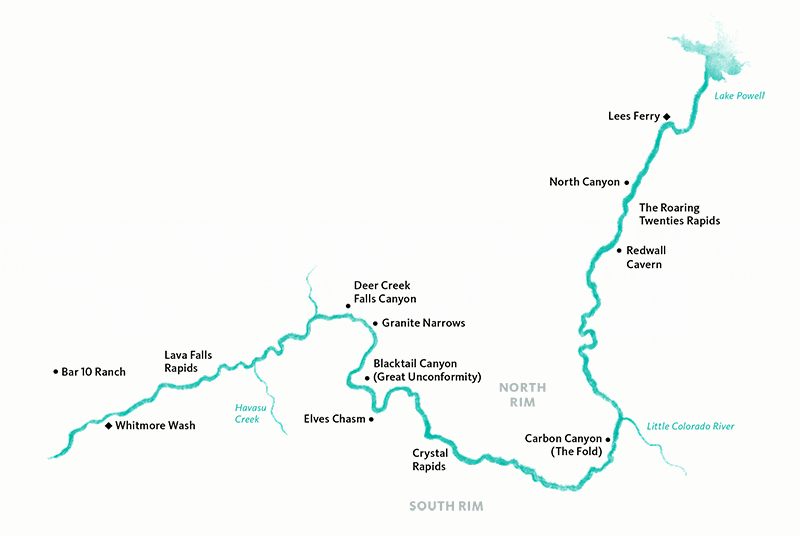
Our trip started at Lees Ferry and ended at Whitmore Wash, 187 miles later. Along the way we ran dozens of whitewater rapids, the most dangerous of which was Crystal Rapids. We hiked numerous side canyons, including Carbon Canyon, which has a massive folded rock layer. The highlight was Blacktail Canyon, where we touched the boundary between creation rocks and the first flood sediments.
Life on the River
We didn’t travel far the first day before setting up camp. Away from the routines of life, it’s easier to focus on the essentials of life, to listen to the still, small voice of God. We’d do this for nine straight days!
On our first morning together, the words rang out that would greet us for the next eight mornings: “H-o-t c-o-f-f-e-e!” Twenty minutes later: “Break-f-a-s-t!” And you’d better be ready. Twenty minutes to eat, finish packing, stop for instructions and devotions, and form lines to pack the raft for the new day.
Each meal was a wonder to behold. Some mornings began with bacon and fried eggs to order, or sausage and pancakes, or who knew what the boatmen would concoct next.
Top-of-the-line coolers made it possible for the boatmen to serve 14-ounce pork chops, chicken breasts, taco salads, and, on the last night, 14-ounce steaks. Every imaginable kind of side dish filled our plates, including mashed potatoes with butter and garlic (made on-site from real potatoes).
Aided by Dutch ovens, our jack-of-all-trades boatmen whipped up fresh-baked cakes, brownies, and strawberry shortcake. “What, no ice cream?” one wag asked.
All four boatmen were hard workers, sometimes putting in 13 hours per day, without complaint. Each one of them loved what they did and knew all about the river and its lore, often regaling us with its stories.
These boatmen, Jake, Zack, Trevor, and John, were always in the backdrop, serving and helping, cooking or cleaning, while the rest of us gathered for devotions, for lectures, or to eat.
Their presence was a constant reminder that our little party wasn’t like the others who frequent the river. They didn’t accept the biblical account of the flood or the Creator’s offer of salvation through Jesus Christ. Even in the Canyon, God brings people into our paths to hear his message.
Canyon Hiking
At daybreak on day two, we gathered in our little circle and Jon warned us about “canyon hiking” later that morning. It wouldn’t be like a walk through the forest. “You’ll soon know what I mean,” he explained.
Some stretches on side canyons are fairly easy, except for occasional thorns from cacti, invasive tamarisk shrubs, and various bushes. Then you hit the rocky hills. In some places, trailblazers maintain something resembling stone steps. In most places, your foot is constantly searching for the next foothold, as you slowly inch from one size of boulder to another. At other times, you must climb straight up a rock face, looking for a handhold—but not always finding one.
Huffing and puffing at each stopping point, I began to wonder if I could make it.
Thankfully, at the worst places, an experienced hiker would stop and lend a hand to stragglers like me, helping us keep our balance when our hands would otherwise have no handhold but thin air.
Yet the views at the end of those long hikes . . . and the lessons I heard about the flood! They made the effort worth it. And as it turned out, at least for me, that first canyon hike was the hardest (though not the longest, highest, or scariest).

I didn’t discover it at first, but as you enter one side canyon after another, you begin to realize that they’re all different. Not just in subtle ways, but obviously. Like the ever-changing character of the rocks surrounding us on the rafts, the little creeks, waterfalls, pools, and plant life in each side canyon had their own unique flavor. All were inspiring and magical.
This first side canyon, North Canyon, included a waterfall and beautiful reflecting pool.
As we rested, Andrew talked about the unusual red rock “layers” that seemed to pop out of the canyon’s sheer walls sideways. I had never seen anything like them, and I wouldn’t again. They looked like sheets of thick rock paper that had spilled out of a notebook at the top and curled down over each other in the narrow path below.
Andrew explained that these formations could happen only if a massive water flow had cut down the canyon rapidly. Once the water was done carving the canyon and disappeared downstream, the released pressure caused the compacted sandstone to pop out in sheets.
I’ve worked with Andrew for 15 years, but I’d never heard this argument! I asked him about this on the way back, and he just shrugged his shoulders, “I guess I haven’t talked to other geologists about this place, and I haven’t written about it before.” The trip would be filled with such nuggets.
That second night I slept well on my little cot. As soon as the sun sets and darkness sweeps over the canyon, you slump onto your cot exhausted, worn out by the new routine. A few hours later the first blue light on the horizon stirs the body to face a new day.
Waking up in the middle of the night, I would stare up at the creamy expanse of the Milky Way for a few minutes. I didn’t even have to fumble for my glasses, stashed somewhere inside my duffel bag. God made sure that every soul on earth, not just in palaces, could witness this spiral arm of our galaxy, filled with billions of stars.
Below the stars, the cliffs stretched off into the distance for miles, while the water gurgled incessantly toward its resting place in the ocean. Scales of wonder, all speaking of their Maker.
Running the Rapids
“We have a great day ahead of us,” Jon announced the next morning. “We’ll hike a little bit later, we’ll do some rafting, and there will be some rocks. That’s the plan for the day.” Laughter.
On the previous day, we had learned about rafting on a long stretch known as the Roaring Twenties. Ten rapids in ten miles. (Twenties refers to the miles from Lees Ferry. Mile 20, mile 21, mile 22, etc.) Eventually, the warning “rapid!” lost its sting.
When I heard Roaring Twenties, I imagined raging waves and walls of water buffeting our tiny craft, but I barely got any splashes. Others on the rafts were oohing and ahhing and screaming, but I wondered if the name was all hype. I thought they would be better named the Murmuring Twenties.
To squeeze every ounce of pleasure out of these ripples, I began asking the boatmen about the art of rafting. The challenges depend on the water flow from Glen Canyon Dam and other factors. I learned about dangers like “pillows” of water forming bumps over hidden boulders, eddies, tongues, and the like.
I also learned that rapids are rated 1 to 10. This rating is based on technical difficulty—challenges for the boatmen, not excitement level for passengers. I gained a whole new perspective on the rapids, seen from our boatmen’s viewpoint.
For the first two days, I was content to lounge in the middle of the boat, taking it easy and talking, while a few brave souls up front took the brunt of the cold and wind.
I asked my neighbors what they were thinking about as the quiet hours rolled by. Like kids finding dragons in the clouds, Kathy and Gordon looked for Picassos and other shapes in the rocks. Others discussed the types of rocks Andrew had identified. Everyone was caught up in the moment, the rim world out of view.
The Sands of Time
That afternoon we finally passed through the last of Marble Canyon and entered Grand Canyon proper.
“Look, there’s the Desert View Watchtower!” Andrew shouted, pointing to a tiny speck on the south rim.
Years before, I had climbed that very tower to look at the river below, which was no bigger than a tiny thread of blue-green yarn. Now I finally got to see from the opposite perspective!
Our long stretch of rafting that afternoon was broken by a hike along the longest tributary of the Colorado that flows into the Grand Canyon. The Little Colorado flows down from the Painted Desert through the Navajo reservation and is considered sacred to the Hopi and other Native Americans.
Most rafters know about this place, famed for its light turquoise water. While we gawked at the water, Andrew pointed excitedly to a little rock next to the river.
It looked like a block cut out of a sand dune, about a square foot, consisting of dozens of sand layers. If you didn’t know any better, you’d think it was part of the Coconino sandstone we’d seen earlier in the trip.
Conventional geologists claim the Coconino sand layers were formed out of wind-blown desert dunes. But creation geologists have studied the rocks directly in the field. They discovered that the sand resembles that on the ocean floor (gentle angles and mixed grain sizes), not steep desert dunes made of fine sand.
More intriguing, this rock had formed since the last flash flood deposited the sand the previous year! This was only the first of several times we observed modern rapid processes that could explain the rock layers around us.
At the end of day three, the rafts turned west, and we would continue in that direction until we reached our final destination. We were sinking deep into the belly of the earth. Soon we would pass below the very lowest deposits from the flood, known as the Tapeats Sandstone.
The Fold
Most exciting of all was our plan to visit “the fold.” Of all the photos I have ever seen in creation literature, one has stood out: Carbon Canyon fold.
On the hike up, I was near the front of the group, right behind Andrew. Finally our path opened into a wide wash, maybe 50 feet across. We stood against one side of the canyon and looked up at the other side.
There it was. Tapeats Sandstone layers ran parallel to the earth and then turned up 90 degrees for a hundred feet, before continuing along the canyon.
Andrew explained that the only way to form such a feature was for the rocks to have been laid down all at the same time, and then for a massive earth movement to shift the whole pile while it was still soft.
As we walked farther up the canyon, past the fold, it opened into a panorama that took my breath away. Here was the great “fault” that had caused large sections of the region to rise high above the other sections. In fact, faulting had produced similar folds in other parts of the canyon, like Muav and Bright Angel. Andrew explained that these layers, supposedly representing over 300 million years, must have been deposited at the same time and still soft, when faulting lifted the Kaibab Plateau in front of us.
As we walked back down to the rafts, we learned that we were stepping through material that existed before the flood. Andrew explained that it was most likely part of the ocean floor during Noah’s day. It was as if God had divided the ocean floor, then lifted it above the sea so I could walk through the ocean bed on dry ground!
The group was amazed at how much we miss God’s wonders until someone with an eye to see points it out.
Our slow and leisurely walk was one of the most pleasant of the whole trip. Along the way, Andrew pointed out various rock features and explained how they were formed from a creationist’s perspective. The group was amazed at how much we would miss of God’s wonders until someone with an eye to see points them out!
That night we had an optional Q&A session, but everyone came. Questions included some of the unsound “evidences” popularized by nonexperts in creationism. I was amazed at how graciously Andrew answered the questions. He admitted the limits of all human knowledge, and pointed out that we must begin with Scripture and trust God above all. Too many Christians rush to find miraculous “silver bullets” that will instantly slay evolution and belief in an old universe.
The Real Rapids
The next morning we heard a lecture explaining how radiometric dates of millions of years are actually based on unproven assumptions. Andrew had waited until the fifth day and a good night’s sleep to broach such a technical topic. “I knew you’d need to be well rested,” he said, with a gleam in his eye.
Today we would finally enter the pink and gray granites and black to gray schist, known as basement rocks, which God had created on the first days of creation week. I had seen diagrams of this and heard about it for nearly 20 years. Now I would see them, the very rocks spoken into existence by the Word of Christ!

We spent the rest of the day running rapids on what all whitewater junkies consider the dream stretch of the Colorado River. It included several 10s, and they were whoppers.
Each rapid had its own name. The guides knew them all by heart and told them all to us (just like Andrew made sure to point out the names of every rock layer).
The names didn’t mean much to me until that evening. Jake, the lead boatman, joined our group and spoke about one in particular that we had run, Crystal. He said it was the deadliest rapid on the river. Literally.
Then he explained in harrowing detail how they must avoid two deadly holes that can flip a boat or grab you and not let go. “I never stop thinking about it,” he confessed. “As soon as I get through it, then I start bracing myself for the next time I have to run it.”
It certainly adds an edge to the thrill. But they waited until after we ran each rapid to tell its stories.
On the same day we ran Crystal, we passed Grand Canyon Village thousands of feet above us. Here millions of tourists come each year to look over the rim for 15 minutes. But we couldn’t see a thing up there except rocks.
Now at the midpoint of the trip, we felt like old pros.
The Great Unconformity
I woke the next morning, shook the sand from my waterproof shoes, and put on an extra layer of clothes to avoid the cold that had chilled my bones the previous day. But today proved to be sweltering, and I soon stripped down to shorts.
This was the big day. We would finally walk right up and touch the Great Unconformity that Andrew had been telling us about.
What is the Great Unconformity? It’s a technical term. At some point in earth history, many lower layers of sediment and basement rocks were tilted up and then sheared off, as cleanly as if a carpenter had sheered a piece of wood with a planer.
You can touch rocks from creation week, and with another hand you can touch early flood deposits. It’s one of the most thrilling things I’ve done.
Most creationists believe the ravaging waters of the flood ripped the pre-flood world down to its roots at this very spot, and then began depositing the sediments stripped from the earth. With one hand you can touch rocks from creation week, and with the other you can touch early flood deposits. It’s one of the most thrilling things I’ve ever done.
“Grand Canyon is not a memorial to the beauty of God’s creation, but a memorial to the judgment of the flood,” Andrew explained. “These rocks speak of the utter destruction of the land and all the creatures on it, as a result of the violence and evil that filled the earth.” Yet God saved faithful Noah and his family, and brought life and beauty out of ashes.
For most people, this was the first time to touch the Great Unconformity, and it was very moving. After Andrew finished his talk, Jon asked everyone to walk in silence from that spot to the end of the side canyon, just around the corner, while we meditated on what we had heard.
After our silent walk was over, we sang, “How Great Thou Art.”
That evening, people shared testimonies about the impact of seeing the Great Unconformity. Then Andrew eloquently described how the flood model explains the world we see today, from the shape of the continents to the formation of the Appalachians, Rockies, Alps, and Himalayas.
The Great Unconformity
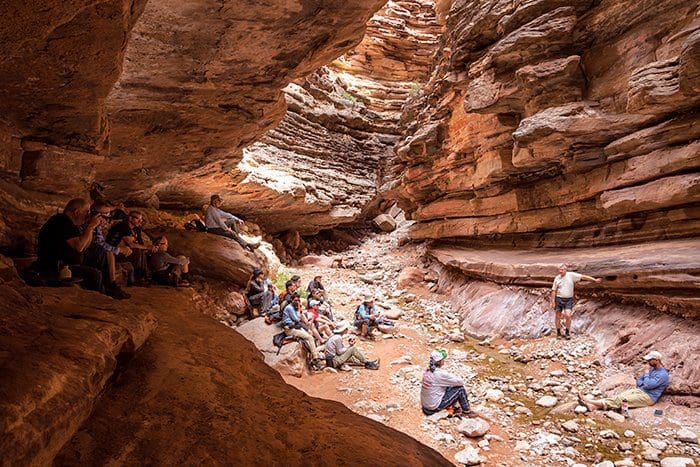
A highlight of the trip came on day six. Geologist Andrew Snelling explained how the destructive waters of the flood sheared off the earth’s surface and then deposited horizontal layers on top. Here in Blacktail Canyon, he could stand on rocks from creation week, and then touch the first deposits laid down during the flood. This contact line between pre-flood rocks and flood deposits is known as the Great Unconformity—a sober reminder that God judges sin.
The Granite Gates
As the seventh day dawned, I realized that I finally had my routine down. I knew where everything was, and I knew where to put everything, without thinking about it.
Today we would pass though the narrowest point of the river, the Granite Narrows, only 76 feet wide. The waters that cut the Grand Canyon couldn’t cut through hard granite as easily as sediments, so less material was removed.
As we approached two tall black cliffs towering overhead, the boatmen cut the motors and strapped the two boats together. We drifted down the calm waters while a member of our party read solemnly from the Gospel of John, chapters 1 and 3. The Word who made all things then dwelt among us and gave his life to save us.
We sang another hymn. “Amazing grace, how sweet the sound.”

Afterward, we stopped at Deer Creek Canyon and hiked up to what is known as the Patio. “If you’re afraid of heights,” Jon warned us, “don’t go on this trip.”
A narrow ledge, 1.5 feet wide, runs along the wall for 30 feet, with a 100-foot drop below. I thought twice (and thrice) about going, and then decided to trust their promise we could make it, if we just took it slowly.
The view at the top was worth it. Stately cottonwoods (the first we’d seen in a canyon) graced the pool’s edge. A clear stream flowed down from woods above then into the canyon below.
We could have spent the whole trip learning about the wonders of the desert plants and animals. We saw many wonderful creatures, like herons, swifts, lizards, catfish, and even a small rattlesnake on our way to the Patio. Just after leaving Deer Creek Canyon, we saw several bighorn sheep climbing the sheer cliffs.
We also witnessed amazing remains of earlier humans, such as handprints left by early Anasazi people high in the cliffs of Deer Creek Canyon. What a grand place Grand Canyon is!
The Earth Belches Its Fury
Our last full day dawned bright and clear.
Today we would see the outpouring of wrath from volcanoes I had first viewed during my flight to Marble Canyon. The first hint was Vulcan’s Anvil, a massive cube of basalt in the middle of the river, around twenty feet high. It was left from an earlier lava flow or perhaps a piece torn from the neck of a volcano. Many Native Americans considered it sacred.
One mile later we passed through the largest navigable whitewater in the Canyon, Lava Falls. And then we saw them: whole valleys filled with the hardened rock from past lava flows. Some basalt deposits were 300 feet thick. In places, we saw where lava had lapped up the other side, and then the raging Colorado River had somehow shattered through the lava dam, leaving behind jagged remains on either side.
Andrew said there were seven successive dams. In one place the river couldn’t break through the dam, so it cut a channel around, through the softer sedimentary rocks. What instruments God used to reshape the earth after the flood!
A Final Day of Reflection
Our trip ended at Whitmore Wash. There, for our final meeting, we were the guest speakers. Each one of us shared “a highlight” (not the highlight, which would be too hard to decide) and a main takeaway—24 people spoke, and they gave at least 22 different answers.
Several people got very emotional. Teachers in churches were concerned about young people and yearned to instill in them the same excitement they now felt about their faith.
Gordon and Kathy, who belong to a liberal denomination, are staying in their church—at least for now—to promote change. “This is another plank to strengthen my faith and give me confidence to share with anyone,” Kathy said.
Many people said they had seen pictures of Grand Canyon’s hidden secrets, “But pictures can’t compare to seeing them.”
Everyone had a better sense of scale—both their own finitude and God’s infinitude.
Andrew and Jon ended with their highlights. “We’re here for you. You’re the highlight of this trip.”
Studying creation involves sharing our experience with others, not just hoarding facts and impressions for our own pleasure. Many voiced similar thoughts.
There’s something powerful about this place. We see all of history in the rocks and have time to think and process what it means.
Then Jon gave the last devotion. “There’s something powerful about this place. We see all of history in the rocks and have time to think and process what it means.
“When you get down here, you’re completely disconnected, literally. You can’t pick up the cell phone. You can’t check the emails. You’re forced to slow down and communicate with people right in front of you.
“When you get back to the rim world, the race does not have to control us. We can make the people in front of us matter, and make our time with God matter.”
He then gave an object lesson with a dry towel and a bucket of water. If we soak our lives full of thoughts about God each day, we can go out into the world and not soak up its contents. A waterlogged towel can even be dipped into gasoline without being affected. But we have to resoak regularly. That’s what is required if we love God with our whole hearts.
“If you’ve learned anything from these nine days, learn how to soak. God is just as powerful up there as he is down here.”
The next morning, a helicopter took us, five or six at a time, to Bar 10 Ranch. In five minutes, we were back to the rim world, where we got a quick shower—if there was time—before we went our separate ways. But we took with us a piece of that world below the rim.
Maybe you have to be there to catch the vision. But I don’t think so. God is everywhere, and he made sure we can draw close to him no matter where we travel, if we just stop long enough to look for him.
The End of the Beginning
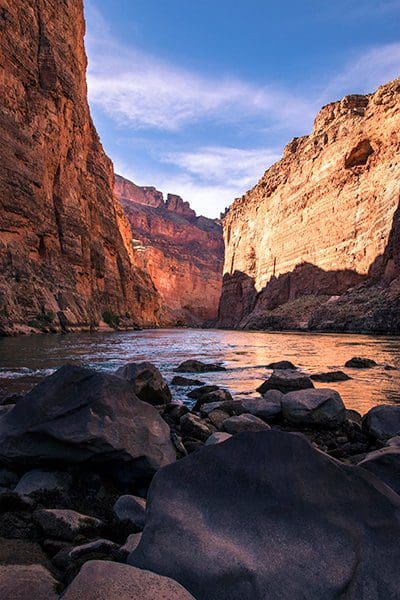
At the start of our journey, our guide warned that it would change us. The end marked the beginning of a new vision of God’s handiwork in our world, both past and present.
earned a BA in English and an MEd in English education from Bob Jones University. Mike served as content manager for the Creation Museum and editor in chief of Answers magazine.

